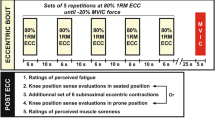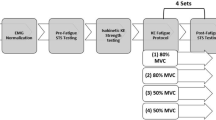Abstract
Previously, data on the effects of muscle fatigue on joint position sense (JPS) have been provided. However, to our knowledge, no studies have been conducted so far to assess the effects of local muscle fatigue on elderly proprioception. Thus, the purpose of the present study was to determine the effects of local muscle fatigue on knee JPS in old-age-subjects. Sixteen male volunteers (mean age ± SD: 69.81 ± 3.92 years) participated in this study. Each subject completed all of the data collection in one morning session; JPS measures were obtained prior to and immediately after the fatigue protocol. JPS was evaluated by the technique of open-kinetic chain and active knee positioning, and was reported using absolute, relative and variable angular errors. The fatigue protocol applied to the lower extremity consisted of 30 maximum concentric repetitions of the knee extensors and flexors muscles on an isokinetic dynamometer at an angular velocity of 120 s−1 (2.09 rad s−1). The results showed that peak torque of knee extensor and flexor muscles was significantly decreased from rest to post exercise-induced fatigue. After local load to the knee muscles, a significant increase of absolute angular error was observed (2.56°). The relative error showed the directional bias in the extension movement. However, the reliability and accuracy of estimating knee angles as showed by the variable error is similar at both times. It can be concluded that exercise-induced local muscle fatigue alters knee JPS in old age adults.

Similar content being viewed by others
References
Bennell K, Wee E, Crossley K, Stillman B, Hodges P (2005) Effects of experimentally-induced anterior knee pain on knee joint position sense in healthy individuals. J Orthop Res 23(1):46–53
Bennett DJ (1994) Stretch reflex responses in the human elbow joint during a voluntary movement. J Physiol 474(2):339–351
Bullock-Saxton JE, Wong WJ, Hogan N (2001) The influence of age on weight-bearing joint reposition sense of the knee. Exp Brain Res 136(3):400–406
Carpenter JE, Blasier RB, Pellizzon GG (1998) The effects of muscle fatigue on shoulder joint position sense. Am J Sports Med 26(2):262–265
Chaffin DB (1973) Localized muscle fatigue: definition and measurement. J Occup Med 15(4):346–354
Enoka RM, Stuart DG (1992) Neurobiology of muscle fatigue. J Appl Physiol 72(5):1631–1648
Forestier N, Teasdale N, Nougier V (2002) Alteration of the position sense at the ankle induced by muscular fatigue in humans. Med Sci Sports Exerc 34(1):117–122
Gandevia SC, McCloskey DI, Burke D (1992) Kinaesthetic signals and muscle contraction. Trends Neurosci 15(2):62–65
Gandevia SC, Enoka RM, McComas AJ, Stuart DG, Thomas CK (1995) Neurobiology of muscle fatigue. Advances and issues. Adv Exp Med Biol 384:515–525
Gregory JE, Morgan DL, Proske U (1988) Aftereffects in the responses of cat muscle spindles and errors of limb position sense in man. J Neurophysiol 59(4):1220–1230
Gregory JE, Mark RF, Morgan DL, Patak A, Polus B, Proske U (1990) Effects of movement history on the stretch reflex in cat and man. J Physiol 424:93–107
Hagbarth K-E, Nordin M, Bongiovanni LG (1995) After-effects on stiffness and stretch reflexes of human finger flexor muscles attributed to muscle thixotropy. J Physiol 482:215–223
Hiemstra LA, Lo IK, Fowler PJ (2001) Effect of fatigue on knee proprioception: implications for dynamic stabilization. J Orthop Sports Phys Ther 31(10):598–605
Horak FB, Shupert CL, Mirka A (1989) Components of postural dyscontrol in the elderly: a review. Neurobiol Aging 10(6):727–738
Lafortune MA, Lambert C, Lake M (1992) Skin marker displacement at the knee joint. In: Proceedings of NACOB II. The second North American congress on biomechanics. NACOB, Chicago, pp 101–102
Lattanzio PJ, Petrella RJ, Sproule JR, Fowler PJ (1997) Effects of fatigue on knee proprioception. Clin J Sport Med 7(1):22–27
Lattanzio PJ, Petrella RJ (1998) Knee proprioception: a review of mechanisms, measurements, and implications of muscular fatigue. Orthopedics 21(4):463–470
Lonn J, Crenshaw AG, Djupsjobacka M, Johansson H (2000) Reliability of position sense testing assessed with a fully automated system. Clin Physiol 20(1):30–37
Lord SR, Ward JA (1994) Age-associated differences in sensori-motor function and balance in community dwelling women. Age Ageing 23(6):452–460
Magalhães J, Oliveira J, Ascensão A, Soares J (2004) Concentric quadriceps and hamstrings isokinetic strength in volleyball and soccer players. J Sports Med Phys Fitness 44(2):119–125
Marks R, Quinney HA (1993) Effect of fatiguing maximal isokinetic quadriceps contractions on ability to estimate knee-positon. Percept Mot Skills 77:1195–1202
Marks R (1994) Effect of exercise-induced fatigue on position sense of the knee. Aust J Physiother 40(3):175–181
McCloskey DI (1978) Kinesthetic sensibility. Physiol Rev 58(4):763–820
Olsson L, Lund H, Henriksen M, Rogind H, Bliddal H, Danneskiold-Samsoe B (2004) Test-retest reliability of a knee joint position sense measurement method in sitting and prone position. Adv Physiother 6(1):37–47
Paillard J, Brouchon M (1974) A proprioceptive contribution to the spatial encoding of position cues for ballistic movements. Brain Res 71:273–284
Pedersen J, Sjolander P, Wenngren BI, Johansson H (1997) Increased intramuscular concentration of bradykinin increases the static fusimotor drive to muscle spindles in neck muscles of the cat. Pain 70(1):83–91
Pedersen J, Lonn J, Hellstrom F, Djupsjobacka M, Johansson H (1999) Localized muscle fatigue decreases the acuity of the movement sense in the human shoulder. Med Sci Sports Exerc 31(7):1047–1052
Petrella RJ, Lattanzio PJ, Nelson MG (1997) Effect of age and activity on knee joint proprioception. Am J Phys Med Rehabil 76(3):235–241
Pickard CM, Sullivan PE, Allison GT, Singer KP (2003) Is there a difference in hip joint position sense between young and older groups? J Gerontol A Biol Sci Med Sci 58(7):631–635
Proske U, Morgan DL, Gregory JE (1992) Muscle history dependence of responses to stretch of primary and secondary endings of cat soleus muscle spindles. J Physiol 445:81–95
Proske U, Morgan DL, Gregory JE (1993) Thixotrophy in skeletal muscle and in muscle spindles: a review. Prog Neurobiol 41(6):705–721
Proske U, Wise AK, Gregory JE (2000) The role of muscle receptors in the detection of movements. Prog Neurobiol 60(1):85–96
Proske U (2005) What is the role of muscle receptors in proprioception? Muscle Nerve 31(6):780–787
Ribot-Ciscar E, Tardy-Gervet MF, Vedel JP, Roll JP (1991) Post-contraction changes in human muscle spindle resting discharge and stretch sensitivity. Exp Brain Res 86(3):673–678
Ribot-Ciscar E, Roll JP (1998) Ago-antagonist muscle spindle inputs contribute together to joint movement coding in man. Brain Res 791(1–2):167–176
Rozzi S, Yuktananandan P, Pincevero D, Lephart SM (2000) Role of fatigue on proprioception and neuromuscular control. In: Lephart SM, Fu FH (eds) Proprioception and neuromuscular control in joint stability. Human Kinetics, Champaign, pp 375–384
Sharpe MH, Miles TS (1993) Position sense at the elbow after fatiguing contractions. Exp Brain Res 94(1):179–182
Skinner HB, Wyatt MP, Hodgdon JA, Conard DW, Barrack RL (1986) Effect of fatigue on joint position sense of the knee. J Orthop Res 4(1):112–118
Stillman B (2000) An investigation of the clinical assessment of joint position sense. In: School of physiotherapy. The University of Melbourne. Available from: http://www.eprints.infodiv.unimelb.edu.au/archive/00 000246/01/Stillman.pdf
Tinetti ME, Speechley M, Ginter SF (1988) Risk factors for falls among elderly persons living in the community. N Engl J Med 319(26):1701–1707
Tully E, Stillman B (1995) A revised model for 2D kinematic analysis of spine, hip and knee motion in the sagittal plane. In: Proceedings of the Twelfth World Congress of Physical Therapy. Washington (DC), pp 732
Van Beers RJ, Sittig AC, Denier van der Gon JJ (1998) The precision of proprioceptive position sense. Exp Brain Res 122(4):367–377
Voight ML, Hardin JA, Blackburn TA, Tippett S, Canner GC (1996) The effects of muscle fatigue on and the relationship of arm dominance to shoulder proprioception. J Orthop Sports Phys Ther 23(6):348–352
Walsh LD, Hesse CW, Morgan DL, Proske U (2004) Human forearm position sense after fatigue of elbow flexor muscles. J Physiol 558(2):705–715
Acknowledgments
We would like to thank Professor João Paulo Vilas-Boas, director of the Biomechanics Laboratory of the Faculty of Sport, University of Porto, and Professor José Soares, director of the Sport Physiology Laboratory of the Faculty of Sport, University of Porto for the use of facilities, and also Engineer Pedro Magalhães for his kind assistance in the kinematic analysis and related procedures.
Author information
Authors and Affiliations
Corresponding author
Rights and permissions
About this article
Cite this article
Ribeiro, F., Mota, J. & Oliveira, J. Effect of exercise-induced fatigue on position sense of the knee in the elderly. Eur J Appl Physiol 99, 379–385 (2007). https://doi.org/10.1007/s00421-006-0357-8
Accepted:
Published:
Issue Date:
DOI: https://doi.org/10.1007/s00421-006-0357-8




